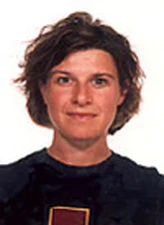Paola Vannucchi

The 2004 Outstanding Young Scientist Award is awarded to Paola Vannucchi for her important studies of subsidence in subduction zones using innovative techniques which have contributed significantly to our understanding of these zones.
Paola Vannucchi is one of the rare young scientists who has successfully taken a wide-ranging multidisciplinary approach to her studies. She is as comfortable studying the interplay between tectonics and fluid flow on rock outcrops as on cores from marine drilling of active continental margins, with skills that range from analyzing rock microstructures in the microscope to looking globally at tectonic processes on the scale of a continental margin or mountain belt. Equally rare, she has a gift for motivating and attracting scientists with complementary skills to work on multidisciplinary problems. Perhaps the best example of this so far has been her collaboration with a paleontologist to constrain (large) subsidence rates in the forearc of the Central American subduction zone, work that provided the key observational evidence to demonstrate that this margin has been the site of large-scale “tectonic erosion” during the past 6Ma. In addition to the analysis of geological samples she has incorporated seismic reflection data, paleontological and paleoceanographic studies and chemical analysis to study material fluxes into subduction zones and the resulting implications for arc volcanism. Her studies of melanges in the Apennines challenged and changed what had long been the “standard” paradigm. Most recently, she has played a leading role in initiating a major program for ocean drilling offshore Costa Rica (the IODP CRISP project), while also writing several significant papers that reassess global subduction processes and study the tectonics linked with plate subduction. In all this, she has already demonstrated her ability to motivate other researchers, and to generously share her ideas and work with co-workers.
